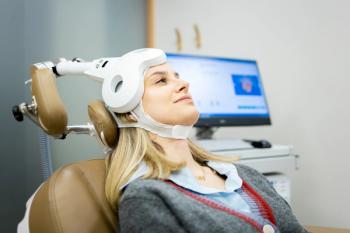
Homing in on an EEG Signature to Predict Antidepressant Response
Investigators used machine learning to derive a unique electroencephalographic pattern or “signature” that appears to predict response to antidepressants vs. placebo.
Harnessing data from EMBARC, the largest placebo-controlled depression trial involving different neuroimaging approaches, investigators used machine learning to derive a unique electroencephalographic pattern or “signature” that appears to predict response to antidepressants vs. placebo. The methodological approach they used to further validate their finding sets an important example for future studies on EEG biomarkers with potential clinical relevance.
RESEARCH UPDATE
Randomized, placebo-controlled antidepressant trials have repeatedly demonstrated the modest superiority of antidepressant over placebo in the treatment of major depressive disorder (MDD).1 Correspondingly, only 1 in 3 depressed individuals remitted on a first trial of antidepressant in the classic STAR*D trial despite measurement-based care and active dose titration.2 These sobering and well-known realities appear to be less related to the weakness of available antidepressants than to the heterogeneity of depression; some individuals respond robustly while others remain depressed.
Roland Kuhn, a pioneer in the development of tricyclic antidepressants,
Given the pervasive disability and suffering associated with depression, the long duration of antidepressant trials in the individual patient, and the uncertainty of the ultimate outcome, the search for meaningful predictors of response has been crucial but unfortunately painstaking and, with the possible exception of pharmacogenomics markers, largely unyielding to date of biological predictors ready for clinical adoption. Amidst the cacophony of biomarker studies,
As
In addition, EEG findings predictive of response in a study sample were associated with nonspecific prediction of response to any treatment or placebo rather than prediction of response to a specific treatment, thereby of questionable relevance to clinical practice in which key questions relate to selection among different agents and treatment modalities. In addition, few EEG studies have compared prediction models based on EEG with prediction derived from other kinds of brain related data such as fMRI or PET resulting in a biomarkers literature which is quite siloed and difficult to integrate.
While much work remains, the intriguing and rigorous study by Wu and colleagues4 suggests a blueprint of progress on all these fronts. In this research, the investigators designed a machine-learning algorithm for resting-state EEG (rsEEG) which they named SparseEEG Latent SpacE Regression (SELSER). They then applied the SELSER algorthim to clinical outcome data derived from the Establishing Moderators and Biosignatures of Antidepressant Response for Clinical Care for Depression (EMBARC) Study, the largest (n=309) placebo-controlled randomized clinical study of antidepressant efficacy that included neuroimaging markers including EEG and fMRI across four study sites using somewhat different EEG set-ups.
Using this machine-learning approach and honing their predictive models to find one that best fit the data across the four sites, they were able to discern an rsEEG signature or pattern at baseline which appeared to be uniquely associated with subsequent response to the selective serotonin reuptake inhibitor (SSRI) antidepressant prescribed in the study (sertraline) while not being associated with response to placebo. That is, the signature seemed to be a marker not for positive outcome generally but to an antidepressant specifically. They then validated the signature in an unrelated sample of antidepressant treated patients in a naturalistic, longitudinal depression study involving various antidepressants and found that the rsEEG signature was both related to antidepressant response, as in EMBARC, and negatively correlated with the number of failed antidepressant trials as would be expected from a biomarker associated with positive antidepressant outcome.
Another question the investigators addressed had to do with whether the rsEEG signature was related to another putative predictive signature that was derived from data in the EMBARC study, one related to fMRI conducted during a so-called emotional conflict task in which participants were presented with emotionally congruent stimuli (such as a fearful face with the word “fear”) or incongruent stimuli (such as a fearful face with the word “happy”) while in the fMRI scanner. They found significant convergence between the rsEEG- and the task-FMRI-derived machine learning predictions, a result that suggests that these two predictive signatures, though derived from different brain imaging modalities, may relate to some common neurobiological phenotype that is associated with responsivity to antidepressants.
Finally, the investigators wanted to know whether the rsEEG signature that predicted response to antidepressant treatment and not to placebo also predicted response to other active treatments. In order to address this question, they studied whether the rsEEG signature predicted response in an independent MDD treatment study of repetitive transcranial magnetic stimulation (rTMS) of the dorsolateral prefrontal cortex (DLPFC) and concurrent psychotherapy.
Rather than finding a convergent relationship in which the rsEEG signature that had predicted antidepressant response in EMBARC also predicted response to rTMS and psychotherapy, however, they found an opposite relationship. Indeed, individuals who had a positive response to rTMS and psychotherapy proved more likely to have an rsEEG signature associated with poor response to sertraline. This finding further supports the potential specificity of the rsEEG signature; it is neither associated with positive response to placebo nor to rTMS and psychotherapy but appears to be associated with positive response to antidepressants per se.
Among the ways such a signature, if confirmed, could advance MDD treatment is that it might help clinicians to identify patients who are good candidates for assertive pharmacotherapy vs. those who might benefit more by fast-tracking to other treatments such as psychotherapy or neuromodulation. Such a signature could help reduce the high rates of placebo responses in clinical trials by pre-selecting subjects with the greatest likelihood of responding to pharmacological agents vs. placebo. Finally, when combined with other probes of brain function, it may help further define the neurobiological phenotype associated with responsiveness to antidepressants generally or particular antidepressants.
In order to more fully understand and trust the potential clinical application of this EEG biomarker for predicting response to antidepressants, additional research is clearly needed. At the very least, this work needs to be extended to diverse, real-world clinical samples receiving a broader range of antidepressants as well as to individuals receiving TMS, ECT, and different forms of evidence-based psychotherapy. It also needs to be compared with findings from other brain imaging techniques beyond the specific task-related fMRI measure in EMBARC.
Nevertheless, the study by Wu and colleagues4 has helped elevate the standard by which other EEG biomarker studies can be assessed; namely they replicated their proposed rsEEG signature in independent samples, found evidence for convergence with other brain biomarkers (fMRI), and were able to distinguish prediction of response to antidepressants from prediction of response to other forms of active treatment or to placebo. These are vital steps on the long but much needed journey toward personalized medicine approaches in depression treatment.
Disclosures:
Dr Alpert is the Dorothy and Marty Silverman Chair of the Department of Psychiatry and Behavioral Sciences at Montefiore Medical Center and Albert Einstein College of Medicine where he is Professor of Psychiatry, Neuroscience, and Pediatrics. The author reports that he receives research support from Otsuka Pharmaceuticals, Axsome Therapeutics, and the Patient-Centered Outcomes Research Institute.
References:
1. Cipriani A, Furukawa TA, Salanti G, et al. Comparative efficacy and acceptability of 21 antidepressant drugs for the acute treatment of adults with major depressive disorder: a systematic review and network meta-analysis. Lancet. 2018;391(10128):1357-1366.
2. Trivedi MH, Rush AJ, Wisniewski SR, et al. Evaluation of outcomes with citalopram for depression using measurement-based care in STAR*D: implications for clinical practice. Am. J. Psychiatry. 2006;163:28–40.
3. Kuhn R.
4. Wu W, Zhang Yu, Jiang J, et al.
5. Widge AK, Bilge MT, Montana R, et al.
Newsletter
Receive trusted psychiatric news, expert analysis, and clinical insights — subscribe today to support your practice and your patients.













